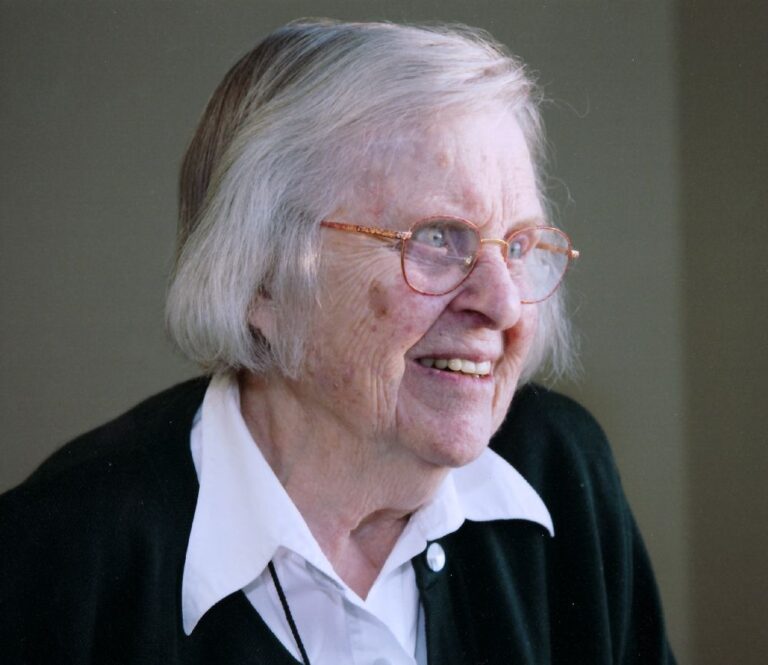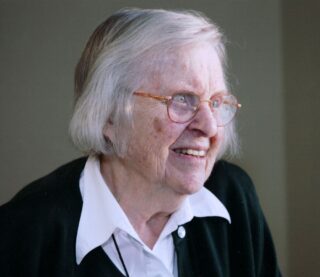- Entry type: Person
- Entry ID: AWE4858
Hyslop, Dorothy Margaret
- AM

- Born 20 January 1916, Melbourne, , Australia
- Died 29 November 2011, Canberra, , Australia
- Occupation Embroiderer
Summary
Since Australia’s ‘new’ Parliament House opened in 1988, millions of visitors have admired one of the key artworks in the Great Hall, the 16 metre long embroidery which celebrates the story of settlement in Australia. A gift from the eight Australian Embroiderers’ Guilds to the nation, the embroidery was conceived, initiated and managed by Dorothy Hyslop, herself an experienced embroiderer and member of the ACT Embroiderers’ Guild. For her vision and achievement of a huge project posing enormous challenges of design and coordination, she was chosen Canberra Citizen of the Year for 1988, made a Member of the Order of Australia in 1989, and appointed a Life Member of the ACT Embroiderers’ Guild in 1992.
Details
Dorothy Margaret Hyslop was born in Melbourne in 1916, the second of three daughters of Frances (née Stabb) and James Fleming, a guard with the Victorian Railways. She initially trained in millinery and design at Swinburne Technical College, but then undertook secretarial studies as hats were not in demand during the depression. This led her to work for Legacy for 10 years, a rewarding position that fulfilled her belief in social justice.
Dorothy married Robert Hyslop (1918-2007) in Melbourne in September 1946. Robert had joined the Commonwealth Public Service in 1936 and remained in the service throughout his career which took the family to the UK in 1958 and then to Canberra when the defence departments moved to the capital in 1959. Their two daughters, Gabrielle and Deirdre, were born in Melbourne.
Once settled herself in Canberra, Hyslop assisted other newly arrived women to settle into their new homes, away from families and communities. From 1970-1974 she and Robert lived in Bangkok where he was Deputy Secretary-General of the South East Asia Treaty Organisation. On her return to Canberra she became an active member of the ACT Embroiderers’ Guild, contributing to their exhibitions and serving as Secretary. Her life was largely that of a supportive wife and mother.
This changed dramatically from 1980 when, aged 64, Dorothy Hyslop proposed to the ACT Embroiderers’ Guild the idea of a major embroidery, to be made by embroiderers around the country and given to the nation to hang in the new Parliament House. She later said the suggestion was greeted with ‘stunned silence’. Few cared for the idea of such a large, collaborative project with all the difficulties that would entail, and the Guild membership was small. At the time, there was little regular communication between the eight State and Territory Guilds and only lukewarm interest in any formal connections.
With fellow Canberra embroiderer Loma Ruddock, Hyslop first obtained the support of the President of the Senate and the Speaker of the House of Representatives for the idea of such a gift. The Art Advisory Committee of the Parliament House Construction Authority funded a design competition and the fees of the designer and embroidery coordinator. The ACT Guild set up a Parliament House Embroidery Committee to oversee the work, which Hyslop convened throughout the eight-year project. In the process, she became a master project manager.
The Parliament House Embroidery was conceived as one of the two major art works for the Great Hall – a frieze in the tradition of the Bayeaux Tapestry, 16 metres long and 65 centimetres deep. Its theme is ‘the settlement of Australia’, in tune with the theme of ‘the land’ for all the public areas of the House. The design competition was won by South Australian artist, Kay Lawrence. The design is unconventional, comprising 24 different images in eight panels, to be read as such rather than as one overall design. It refers to each State and Territory in particular images but emphasises common elements in the experience of settlement rather than distinct, State-based differences. It moves from Aboriginal people’s harmonious relationships with the land to the changes wrought by European settlers through the 19th Century. It conveys beauty and ugliness, joy and loss.
Over a thousand women around Australia were involved in the work – some in making the hundreds of samplers from which stitches and colours were selected, others in preparing the linen and stretching it onto frames before work began, others in preparing the pieces for transport to Canberra, or in joining the sections and mounting the completed work in its case. Twelve thousand unpaid hours of embroidered stitching were put into the eight panels by 504 women, 150 of them in Canberra. Their work was coordinated by master embroiderer Anne Richards and a supervisor in each State and Territory. The Guilds donated not only their labour but also all the funds needed for the materials. The linen and threads were intensively researched and of the highest quality. Along with her national project management role, Hyslop and the ACT Guild held fundraising exhibitions and raffles to help pay for their contribution.
It was a bold project, full of challenges in design, coordination and quality control, and with the potential for nightmare. Two States withdrew from the project but later re-joined. Hyslop understood the importance of good communication to overcome doubts and misunderstandings. She and her team kept up a copious correspondence with letters, tape recordings and newsletters and, occasionally, face to face meetings to share ideas and strengthen the trust that gradually developed among the participants. Kay Lawrence later attributed Hyslop’s success to ‘vision, unwavering faith in the expressive potential of embroidery, a belief in teamwork, the capacity to identify and recruit key people, exceptional project management skills, and tenacity; all of this in a tiny woman… with a kind and mild demeanour… and no ego’ (Lawrence 2011, p.4).
The embroidery was presented to the Presiding Officers of the Parliament on 25 May 1988. Within a decade it had been seen by some 14 million visitors to Parliament House. It is universally acknowledged as a nationally significant artwork and has given prominence to a long undervalued medium. In recognition of her vision and achievement, Dorothy Hyslop was chosen Canberra Citizen of the Year for 1988, made a Member of the Order of Australia in 1989, and appointed a Life Member of the ACT Embroiderers’ Guild in 1992. She died in Canberra in 2011.
Archival resources
Digital resources
Published resources
-
Newspaper Article
- Bureaucrat had theatrical flair, Stephens, Tony, 2007, http://www.smh.com.au/news/obituaries/bureaucrat-had-theatrical-flair/2007/10/02/1191091110011.html
- Journal Article
- Speech
- Lecture
- Book
-
Site Exhibition
- From Lady Denman to Katy Gallagher: A Century of Women's Contributions to Canberra, Australian Women's Archives Project, 2013, http://www.womenaustralia.info/exhib/ldkg
-
Resource
- Trove: Hyslop, Dorothy Margaret (19160120-20111129), http://nla.gov.au/nla.party-1665909
